Abstract
With the gradual densification of China’s railway network, more and more railways are inevitably crossing active fault zones. Creep dislocation and stick–slip dislocation of the fault zones can lead to uneven deformation and cracks in the railway subgrade, threatening the sustainability of the railway. Therefore, a model test and numerical simulation were used to analyze the deformation mechanism and sustainability of the subgrade and foundation induced by a strike–slip fault dislocation in a flat site under different angles between the subgrade and fault strikes. The test and simulation results show that (1) under the influence of strike–slip fault dislocation, the horizontal direction of the subgrade appeared to have an S–shaped displacement. The top surface of the subgrade appeared to have a vertical settlement. Further, tension–shear cracks and compression crush zones appeared on the subgrade’s surface. (2) When the angle between the fault and subgrade strikes increased, the subgrade’s uneven deformations induced by fault dislocation first decreased and then increased. The angle between the main tension–shear crack on the top surface of the subgrade and the fault strike showed a trend of increasing and then decreasing. In addition, the compressive stress along the subgrade strike decreased, while the tensile stress along the subgrade strike gradually increased. (3) The tension–shear cracks in the subgrade and foundation were spiral and converged to the basement strike–slip fault along the depth direction. This study provides a reference for the safe operation and sustainability of railways near faults.
1. Introduction
The southwestern and northwestern regions of China have been affected by compression between the Indian and Eurasian plates. As a result, active fault zones are widely distributed. With the rapid development of railway constructions in these areas, the railway network in the southwest and northwest of China has become increasingly dense. More and more railways are facing the challenge of crossing active fault zones [1,2,3,4,5]. In a seismic recurrence cycle, fault zone deformation can be divided into coseismic, interseismic, and postseismic deformation. Interseismic and postseismic creep and coseismic stick–slip can cause uneven deformation of the railway subgrade, threatening the long–term operational safety and sustainability of the railway [6].
Researchers have mainly studied the influence of fault dislocation on surface deformation and structural sustainability through model tests and numerical simulations. Researchers like Riedel [7] and Naylor et al. [8] used wet clay and quartz sand as experimental materials to conduct deformation experiments on the overlying layers underneath the strike–slip fault movements. The secondary structures associated with strike–slip faults are primarily categorized into R cracks, R’ cracks, P cracks, T cracks, Y cracks, and compressive folds. Savage et al. [9] developed a theoretical formula for the interseismic surface deformation of strike–slip faults. Cai et al. [10] conducted centrifuge model experiments on fault dislocation, analyzing the deformation evolution patterns of interlayer soil fracture induced by normal fault movements in the presence of hidden fractures. Hardy et al. [11] used a discrete element numerical simulation to analyze the impact of reverse fault movements on the development of folds in the overlying sedimentary layers. Zhang et al. [12] conducted model tests on subgrade deformations induced by reverse fault movements. The damage and fracture characteristics of natural subgrades and subgrades reinforced with various anti–displacement measures were studied. Ai [13] and Ji [14] conducted model tests and a finite element analysis for different angles between the subgrade and the fault zone and the amount of fault displacement to analyze the mechanism of subgrade deformation damage induced by the fault dislocation. Ma [15] developed model test equipment suitable for analyzing the impact of fault dislocations on tunnel deformation. Through numerical simulations and model tests, the deformation and failure mechanisms of tunnel structures under different fault dip angles, fault dislocation speeds, and dislocation amounts were revealed. Li [16] studied the stress and deformation of a metro viaduct under the action of a fault dislocation. He put forward engineering prevention measures for viaducts crossing a fault zone.
To sum up, there is still little research on the impact of fault dislocation on the sustainability of railway subgrades. In current fault dislocation model tests, scholars still rely on the naked eye and ruler measurements to qualitatively analyze the influence range and degree of subgrade deformations in fault dislocation tests. At present, there is a lack of precise monitoring means to analyze the deformation laws of various parts of the subgrade in the process of fault dislocation tests. Regarding numerical simulations, the development law of cracks in subgrades under the dislocation of strike–slip faults has rarely been analyzed in previous finite element calculations. Although discrete element simulations can accurately analyze the deformation and crack development of subgrades, their calculation speed is slow, and they are unable to quickly carry out multi–condition numerical simulation calculations to analyze the propagation and evolution law of deep fracture traces in large–scale subgrades under strike–slip fault dislocations. Therefore, the research on the mechanism of subgrade damage under fault dislocations is still insufficient.
Strike–slip earthquakes have accounted for nearly 50% of the total earthquakes recorded in China with a magnitude of ≥5 since 1970 [17]. Therefore, using model tests and numerical simulations, this paper analyzes subgrades’ damage and failure mechanisms under fault dislocations. The research results can support the long–term stability and sustainability of railways near faults.
2. Model Tests of Fault Dislocation
2.1. Development of Test Modeling Equipment
The fault dislocation model test equipment is shown in Figure 1. The test equipment consists of a model box and a loading system. The maximum size of the internal space of the model box is 1000 mm × 1000 mm × 870 mm (length × width × height). Tempered glass plates are set at the box’s left, front, and rear sides to facilitate the observation of soil deformation and fractures during the test. Two rigid base plates are set at the bottom of the model box. The left base plate is the fault fixed plate, and the right is the fault dislocation plate. The dimensions of the two base plates are 1000 mm × 500 mm × 15 mm (length × width × thickness). A stainless–steel L–shaped boundary of multiple steel bars is set above the right bottom plate. An adjustable speed motor and screw pusher are set in front of the model box. Driven by the motor, the screw pusher connected to the right bottom plate can move horizontally back and forth to realize the simulation of strike–slip fault dislocation. The maximum stroke of the screw rod is 100 mm. The variable speed range of the loading system is 0–1 mm/s.
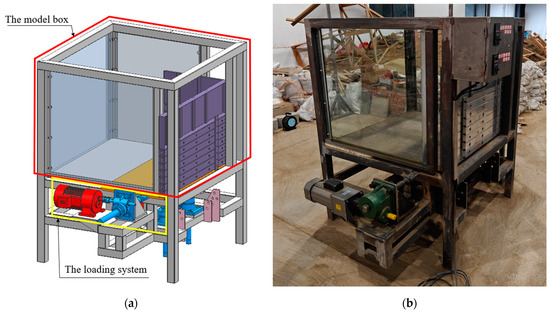
Figure 1.
Fault dislocation model test equipment.
2.2. Material Selection and Similar Design
Based on the experimental equipment’s size and conditions, the geometric similarity ratio of the fault dislocation model tests is determined to be 1:50. The similarity constants for various physical quantities are obtained according to the similarity criteria, as shown in Table 1.

Table 1.
Parameters’ similitude relationships.
Based on the parameters’ similitude relationships, the main parameter values of the test model materials are obtained. The subgrade and foundation soil layers are controlled by cohesion and internal friction angles.
2.3. Model Establishment
According to the Code for Design on Subgrade of Railway (TB 10001–2016) [18], the model’s size is determined according to the design speed of a 350 km/h high–speed railway single–line subgrade. The filled model is shown in Figure 2. α represents the angle between the subgrade and fault strikes. In order to analyze the influence of the angle between different subgrade strikes and fault strikes on the deformation and sustainability of the subgrade under the strike–slip fault dislocation, it is necessary to conduct tests for three scenarios: a flat site, α = 90°, and α = 45°. The width of the top surface of the subgrade is 176 mm. The width of the bottom surface is 356 mm. The height is 60 mm. The ratio of the subgrade slope is 1:1.5. The height of the foundation is 100 mm. The subgrade and foundation model should be filled in layers. After each layer is filled and compacted, ring knife sampling and direct shear tests are required to control the compaction quality of the model. It is necessary to ensure that the material parameters at different positions in the same material are consistent. After filling the upper soil, the excess material should be cut according to the subgrade slope rate to form the overall contour of the subgrade.
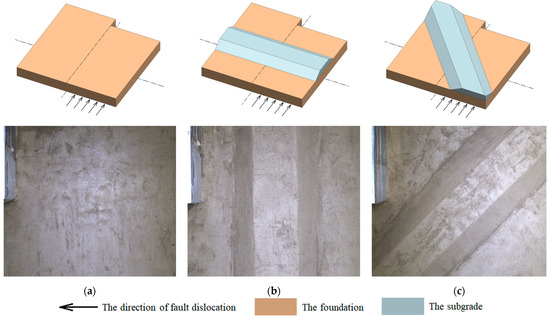
Figure 2.
Test conditions: (a) no subgrade; (b) α = 90°; (c) α = 45°.
2.4. Monitoring System Deployment and Testing Process
In order to quantitatively analyze the deformation of the foundation and subgrade induced by the fault dislocation, as shown in Figure 3, a steel bracket is set to fix an industrial camera on the beam above the bracket. The MV–CS200–10UC (Hikrobot, Hangzhou, China) is selected as the industrial camera, with a 5472 × 3648 px resolution. During the test, the industrial camera takes photos at an interval of 0.5 s to record the fault dislocation deformation process. After the test, a PIV analysis of the photos is performed. PIV (particle image velocimetry) [19,20,21] is an image–processing technology that can accurately and quantitatively analyze the displacement of soil particles. In geological engineering, PIV has been widely used in the physical model test of fault zone dislocation sandboxes [22], but it is rarely used in the model test of the influence of fault dislocations on subgrades. By dividing a large number of pixels in the photo taken at time t into several interpretation areas, recording the location of soil particles in each interpretation area, and searching for the location of soil particles in the surrounding area of the same interpretation area in the photo taken at a particular time (t + Δt), the displacement vectors of soil particles at different positions in the model can be quantitatively revealed.
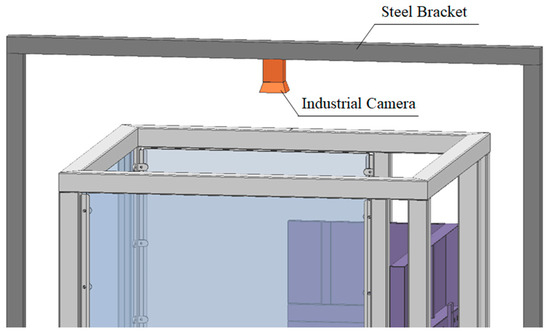
Figure 3.
Steel bracket and industrial camera for monitoring soil deformation.
Before starting the test, the motor speed should be set on the motor control panel. Photos should be taken to record the soil deformation after the tests start. The test should be stopped when the displacement of the fault dislocation plate is 40 mm. All the test faults in this paper are sinistral strike–slip faults. The fault dislocation rate is 0.15 mm/s.
3. Analysis of Test Results
3.1. The Deformation of Flat Site without Subgrade
Figure 4 shows the gradual evolution process of the surface cracks in the case of the flat site without a subgrade. The letter d denotes the magnitude of fault dislocation. At the initial stage of the fault strike–slip dislocation, there was no obvious rupture or strain concentration on the surface. The strain was mainly adjusted by the rolling rearrangement of soil particles. When the strike–slip dislocation of the fault was 5 mm, a small number of cracks developed on the surface. These cracks are the combination of tension and shear cracks. They can be called the tension–shear cracks. Tension–shear cracks are marked with red solid lines. They had the deformation characteristics of R cracks, P cracks, and T cracks. The cracks were arranged in the form of an en echelon. The angle between the surface cracks and the fault strike was about 25°–45°. With the gradual increase in the strike–slip displacement of the fault, the number and width of tension–shear cracks gradually increased. The soil was pushed toward the dislocation plate and the fixed plate. With a surface uplift, folds began to appear at both ends of the tension–shear cracks. The compression crush zones were developed. They are marked with blue dotted lines. The angle between the compression crush zone and the fault strike was about 0°–10°, which delineated the left and right boundaries of the tension–shear cracks. As the strike–slip displacement continued to increase, the surface nappe uplift phenomenon was further intensified, and the compression crush zones were further developed. Finally, the compressional crush zones were completely connected on the surface. After the test, when gently pressing the soil with our fingers, we found that the soil in the superimposed uplift area became very soft compared to the surrounding soil, indicating that the compactness of the soil in the superimposed uplift area was reduced due to the influence of the soil pushing towards both sides and the tension–shear of the fault. If the displacement continued to increase, the nappe uplift phenomenon would not have happened. The soil may have settled and collapsed.
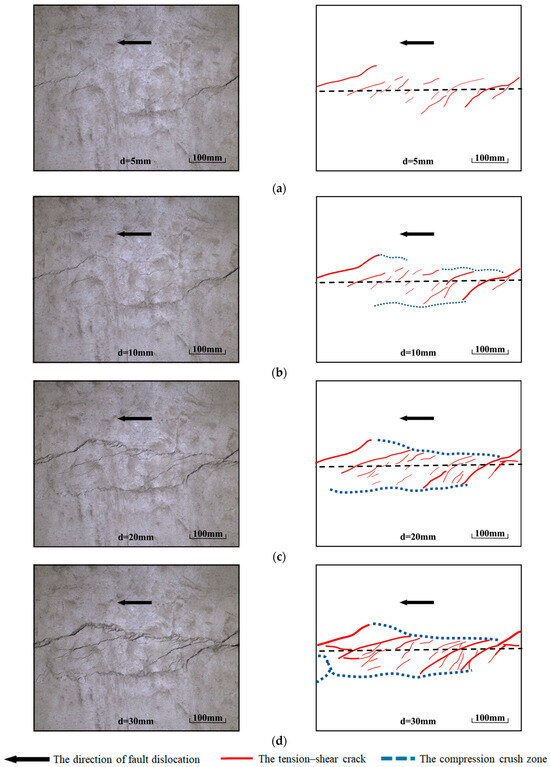
Figure 4.
Model test results of fault dislocation on a flat surface without a subgrade. (a) The result of surface deformation due to a fault slip of 5 mm; (b) the result of surface deformation due to a fault slip of 10 mm; (c) the result of surface deformation due to a fault slip of 20 mm; (d) the result of surface deformation due to a fault slip of 30 mm.
3.2. The Deformation of Subgrade
3.2.1. The Deformation Induced by Slight Fault Dislocation
According to the geometric similarity ratio of the test model, considering the influence of the cumulative displacement of the fault dislocation on the sustainability of the subgrade within 100 years, which is calculated from the fault dislocation rate of 3 mm/a, it is necessary to analyze the deformation evolution process of the subgrade under the condition of α = 45° and α = 90° within the range of 0–6 mm of the strike–slip fault dislocation. Figure 5 and Figure 6 show the distribution of cracks on the subgrade’s surface under two conditions. The letter d denotes the magnitude of fault dislocation. It can be seen that at the early stage of the fault dislocation, as shown in Figure 5a and Figure 6a small number of tension–shear cracks began to appear on the surface, while no cracks occurred on the subgrade surfaces under both conditions. The subgrade displacement was absorbed by a wide range of shear bands, and the subgrade surface deformation was diffused. When the fault dislocation was 3.6 mm, as shown in Figure 5b and Figure 6b, a small number of tension–shear cracks appeared on the upper part of the subgrade slope and the top surface under both conditions. Upon further increasing the amount of fault creep dislocation, as shown in Figure 5c and Figure 6c, the number of cracks on the subgrade surface and the length of each tension–shear crack increased slightly. Taking the intersection of the centerline of the subgrade’s top surface and the fault strike as the center, the cracks on the subgrade surface were roughly distributed in a centrosymmetric manner.
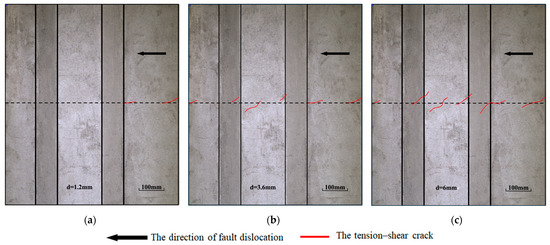
Figure 5.
The distribution of cracks under the condition of α = 90°. (a) The result of subgrade deformation due to a fault slip of 1.2 mm; (b) the result of subgrade deformation due to a fault slip of 3.6 mm; (c) the result of subgrade deformation due to a fault slip of 6 mm.
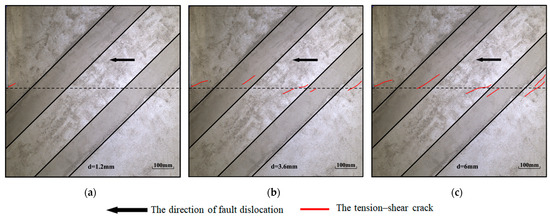
Figure 6.
The distribution of cracks under the condition of α = 45°. (a) The result of subgrade deformation due to a fault slip of 1.2 mm; (b) the result of subgrade deformation due to a fault slip of 3.6 mm; (c) the result of subgrade deformation due to a fault slip of 6 mm.
Figure 7 and Figure 8 show the model displacement field when the fault displacement increased from 2.4 mm to 3.6 mm under the conditions of α = 90° and α = 45°. From the X–direction displacement field, it can be seen that the more obvious displacement vectors were concentrated in the soil above the fault dislocation plate, while the soil above the fault fixed plate remained static during the test. The X–direction displacement vectors of the soil near the fault show a gradual transition process from the staggered disk to the fixed disk. This gradual process led to an adverse effect on the sustainability of the subgrade near the fault. From the Y–direction displacement field, it can be seen that under the condition of α = 45°, taking the projection trace of the fault plane on the ground surface as the boundary, the subgrade top surface and slope soil were pushed to the fault dislocation plate and the fixed plate, respectively; under the condition of α = 90°, the surface deformation was affected by the subgrade slope. For the subgrade slope direction opposite the fault dislocation, the slope mainly presented a nappe deformation in the direction of the fault dislocation plate. For the subgrade slope direction consistent with the fault dislocation direction, the slope mainly presented a nappe deformation in the direction of the fault fixed plate. The deformation characteristics of the subgrade top surface were basically consistent with those of the leveling site.
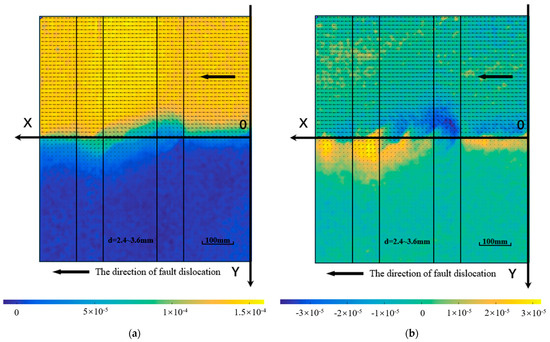
Figure 7.
Model displacement field when the fault displacement increases from 2.4 mm to 3.6 mm under the condition of α = 90°. (a) X−direction displacement field; (b) Y–direction displacement field.
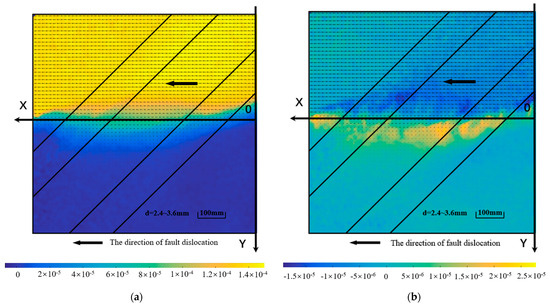
Figure 8.
Model displacement field when the fault displacement increases from 2.4 mm to 3.6 mm under the condition of α = 45°. (a) X–direction displacement field; (b) Y–direction displacement field.
Figure 9 and Figure 10 show the deformation curve of the centerline of the subgrade top surface extracted from the X–direction and Y–direction displacement fields. It can be used to analyze the influence of fault zone dislocations on railway regularities. The zero line of the abscissa axis is located on the projection trace of the fault plane on the top surface of the subgrade. It can be seen that perpendicular to the subgrade strike, the deformation characteristics of the subgrade top surface presented an S–shaped displacement. For the same fault displacement, perpendicular to the subgrade strike, the influence range of the uneven deformation of the subgrade top surface under the condition of α = 45° was significantly larger than when α = 90°. Parallel to the direction of the line, under the condition of α = 45°, the deformation characteristics of the subgrade top surface still showed an S–shaped displacement. Under the condition of α = 90°, the deformation curve reflected the deformation characteristics of the soil on the top of the subgrade that was pushing toward the fault displacement plate and the fixed plate, respectively. With the gradual increase in the fault displacement, the amount of nappe deformation also increased.
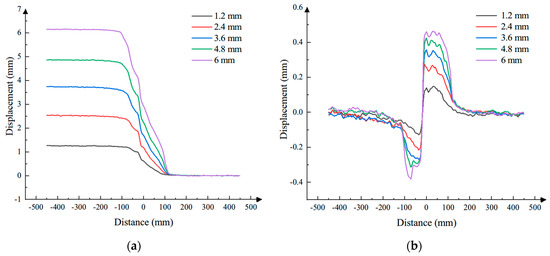
Figure 9.
The deformation curve of the subgrade’s top surface through PIV under the condition of α = 90°. (a) The deformation perpendicular to the subgrade strike; (b) the deformation parallel to the subgrade strike.
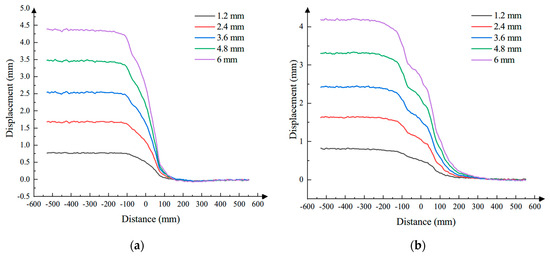
Figure 10.
The deformation curve of the subgrade’s top surface through PIV under the condition of α = 45°. (a) The deformation perpendicular to the subgrade strike; (b) the deformation parallel to the subgrade strike.
3.2.2. The Deformation Induced by Severe Fault Dislocation
According to the geometric similarity ratio of the test model, considering the influence of the fault stick–slip dislocation on the sustainability of the subgrade according to a strike–slip fault dislocation of 2 m, it was necessary to analyze the subgrade deformation evolution process under the conditions of α = 90° and α = 45° when the fault dislocation was 40 mm. Figure 11, Figure 12, Figure 13 and Figure 14 show the distribution of cracks and the strain fields on the subgrade surfaces under the conditions of α = 90° and α = 45°. In these figures, the solid red line represents the tension–shear crack. The blue dotted line represents the compression crush zone. The solid purple line represents the main tension–shear crack. It can be seen that with the gradual increase in the fault dislocation, the number of cracks on the subgrade surface further increased. The length and width of the cracks also increased. The sustainability of the subgrade was damaged. The compression crush zones began to appear in some parts of the subgrade slope, resulting in a swelling deformation of the slope. However, the scale of tension–shear cracks in the condition of α = 45° was smaller than in α = 90°. Taking the intersection of the centerline of the subgrade’s top surface and the fault strike as the center, the tension–shear cracks and compression crush zones were roughly distributed in a centrosymmetric manner. If the fault displacement increased further on the basis of 30 mm, the strain was mainly concentrated in the main tension–shear crack, as shown in Figure 12c and Figure 14c. The number and width of the remaining cracks did not change significantly. The development of the nappe uplift in the middle of the subgrade top surface could be prohibited by the continuous expansion of the main crack, causing some soil on the subgrade top surface to collapse downward, as shown in Figure 15. It can be seen that there was a cavity in the subgrade.
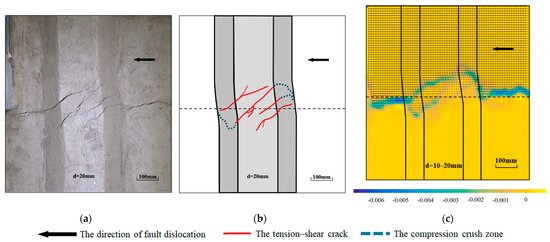
Figure 11.
Model test results when the fault displacement is 20 mm under the condition of α = 90°. (a) Test photo; (b) the distribution of tension–shear cracks and compression crush zones; (c) the strain field.
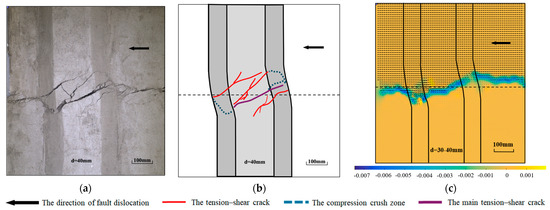
Figure 12.
Model test results when the fault displacement is 40 mm under the condition of α = 90°. (a) The test photo; (b) the distribution of tension–shear cracks and compression crush zones; (c) the strain field.
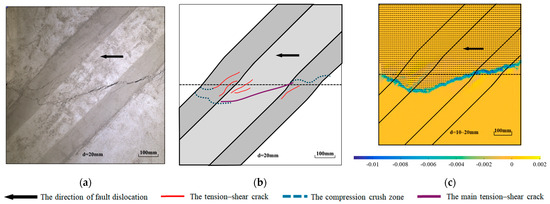
Figure 13.
Model test results when the fault displacement is 20 mm under the condition of α = 45°. (a) The test photo; (b) the distribution of tension–shear cracks and compression crush zones; (c) the strain field.
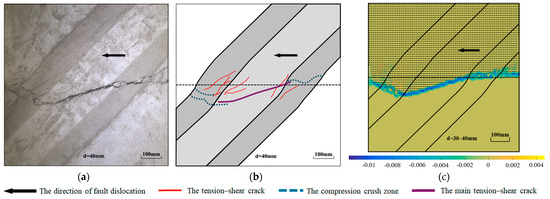
Figure 14.
Model test results when the fault displacement is 40 mm under the condition of α = 45°. (a) The test photo; (b) the distribution of tension–shear cracks and compression crush zones; (c) the strain field.
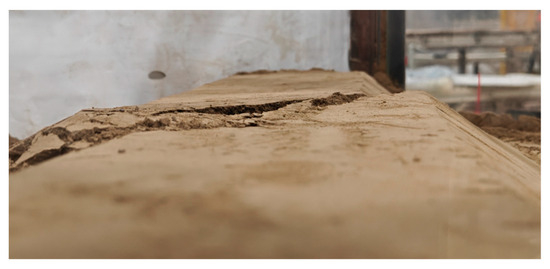
Figure 15.
Subgrade settlement.
4. Numerical Simulation Calculation of Fault Dislocation
4.1. Establishment of Numerical Simulation Models
In order to analyze the sustainability of the subgrade further, the deep fracture trace of the subgrade and the stress and deformation under a fault dislocation need to be observed. It was necessary to carry out numerical simulation calculations of the fault dislocation, as shown in Figure 16. Seven numerical simulation models, with angles of 22.5°, 45°, 67.5°, 90°, 112.5°, 135°, and 157.5° between the fault and subgrade strikes, were created. The models are shown in Figure 17. The yellow part represents the fault dislocation plate, and the gray part represents the fault fixed plate. The models were created by Midas GTS NX. Then, the models were imported into the GDEM 1.0.60.1730 numerical simulation software developed by the Institute of Mechanics, Chinese Academy of Sciences, Beijing, China, for calculation.
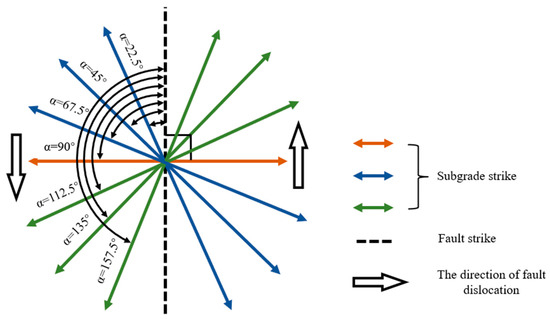
Figure 16.
The relative position between the fault and the subgrade.
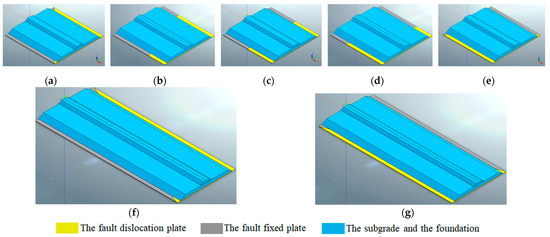
Figure 17.
Numerical simulation models created in Midas GTS NX. (a) α = 45°; (b) α = 67.5°; (c) α = 90°; (d) α = 112.5°; (e) α = 135°; (f) α = 22.5°; (g) α = 157.5°.
The models were mainly composed of bedrock, foundation, and subgrade. The normal behavior of the contact surface was defined as hard contact, and the tangential behavior was defined as smooth without friction. The thickness of the model bedrock was 1 m. The thickness of the foundation was 5 m. The width of the top surface of the subgrade was 8.8 m. The width of the bottom surface was 17.8 m. The height was 3 m. The ratio of the subgrade slope was 1:1.5. In order to reduce the influence of the boundary effect on the subgrade deformation in the process of the strike–slip fault dislocation as much as possible and avoid the collapse of the foundation unit, slope–cutting treatment was carried out on the foundation at the boundaries of both sides of the model, with a slope cutting gradient of 30°. Therefore, when α was 45°, 67.5°, 90°, 112.5°, and 135°, the length of the model along the subgrade strike was 100 m. The width of the bedrock perpendicular to the subgrade strike was 98 m. The width of the top surface of the foundation was 70 m. The width of the foundation bottom was 87.32 m. When α was 22.5° and 157.5°, the length of the model along the subgrade strike was 240 m.
4.2. Model Assumptions and Calculation Parameters
The calculation assumed the subgrade and its lower foundation had an isotropic homogeneous body. The initial displacement and stress fields caused by the gravity of the subgrade and foundation had to be considered. The linear elastic model was adopted for the bedrock. The strain softening Mohr–Coulomb model was adopted for the subgrade and foundation. The specific calculation parameters are shown in Table 2.

Table 2.
The physical–mechanical parameters of rock and soil.
In the strike–slip fault dislocation calculation stage, the velocity excitation was applied to the “yellow” unit in Figure 17. The fracture was an important index for evaluating the sustainability of the subgrade. By monitoring the change in the combined damage factor, the subgrade and its lower foundation fracture induced by a fault dislocation were analyzed. The combined damage factor comprises shear and tensile damage factors. The calculation formulas for the three damage factors are as follows:
where p is the shear damage factor, q is the tensile damage factor, r is the combined damage factor, c0 is the initial cohesion of the element, cn is the current cohesion of the element, σ0 is the initial tensile strength of the element, σn is the current tensile strength of the element. When the combined damage factor of the element is 1, it means that the element has been destroyed and the crack has occurred.
5. Analysis of Numerical Simulation Results
5.1. Stress Distribution
Figure 18 and Figure 19 show the stress distribution in the direction of the railway on the subgrade surface. When α = 90°, at the initial stage of the fault strike–slip dislocation, as shown in Figure 18a, for the subgrade slope direction opposite to the direction of fault dislocation, there was a tensile stress concentration on the slope above the fixed plate, while there was a compressive stress concentration on the slope above the dislocation plate. The situation was the opposite for the subgrade slope direction, consistent with the fault dislocation direction. Taking the intersection of the fault strike and the subgrade centerline as the center, the tensile and compressive stress of the subgrade were distributed in a centrosymmetric manner. The maximum tensile stress appeared at the top of the subgrade slope. When the strike–slip fault displacement was further increased, as shown in Figure 18b, the tensile stress area gradually moved to the upper part of the subgrade slope and the top surface of the subgrade, which was the main reason for a small number of tension–shear cracks in the upper part of the subgrade slope and the top surface of the subgrade in the condition of α = 90° in the test model, while the compressive stress was the main reason for the compression crush zone in the subgrade slope.

Figure 18.
The stress along the subgrade strike calculated by GDEM. (a) The stress under the condition of α = 90° in the early stage of fault dislocation; (b) the stress under the condition of α = 90° in the later stage of fault dislocation.
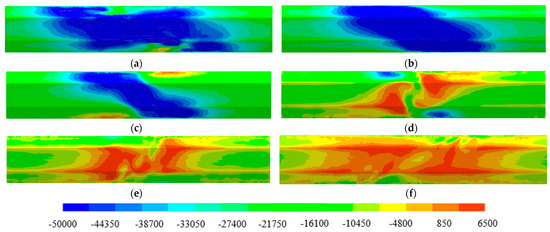
Figure 19.
The stress along the subgrade strike calculated by GDEM. (a) α = 22.5°; (b) α = 45°; (c) α = 67.5°; (d) α = 112.5°; (e) α = 135°; (f) α = 157.5°.
As the angle between the fault strike and the subgrade increased, as shown in Figure 19, the range of compressive stress gradually decreased, and the range of tensile stress gradually increased.
5.2. Combined Damage Factor
Figure 20 and Figure 21 show the combined damage factors of all elements in the model. The elements with the combined damage factor of 1 are marked in red. It can be seen from Figure 21 that the development characteristics of surface cracks on both sides of the subgrade were basically consistent with the model test results, which is reflected in the fact that the tension–shear cracks were arranged in the form of an en echelon. With the gradual increase in the fault displacement, isolated tension–shear cracks on the foundation surface became connected. The cracks gradually extended to the subgrade surface. The sustainability of the subgrade was damaged severely.

Figure 20.
The combined damage factors of the models calculated by GDEM. (a) The factors under the condition of α = 90° in the early stage of fault dislocation; (b) the factors under the condition of α = 90° in the later stage of fault dislocation.
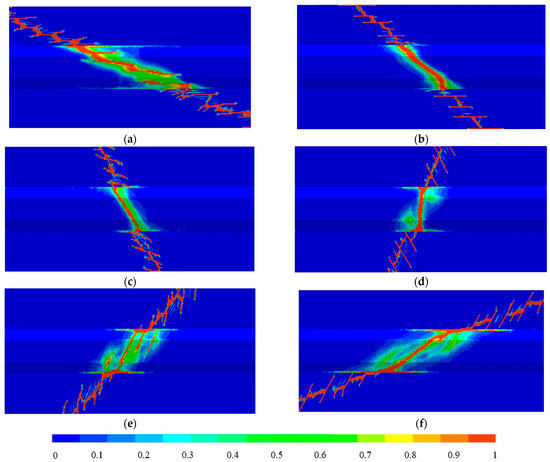
Figure 21.
The combined damage factors of the models calculated by GDEM. (a) α = 22.5°; (b) α = 45°; (c) α = 67.5°; (d) α = 112.5°; (e) α = 135°; (f) α = 157.5°.
By observing the characteristics of the cracks on the top surface of the subgrade, it can be found that there was an angle between the main tension–shear crack on the top surface of the subgrade and the fault strike. This angle was β, which increased and then decreased with the increase in α. The maximum angle was 17.5°, and the minimum was 6.5°, as shown in Figure 22.
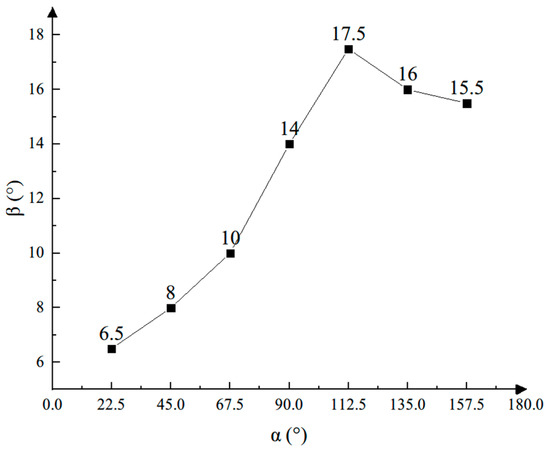
Figure 22.
The relationship between β and α.
Figure 23 shows the model profiles under the condition of α = 90°. It can be seen that the tension–shear cracks formed inside the subgrade and the foundation spiraled. With the increase in the depth of the subgrade and foundation, the angle between the cracks and the fault strike gradually decreased. The damage range also gradually decreased. The cracks converged to the basement strike–slip fault along the depth direction.
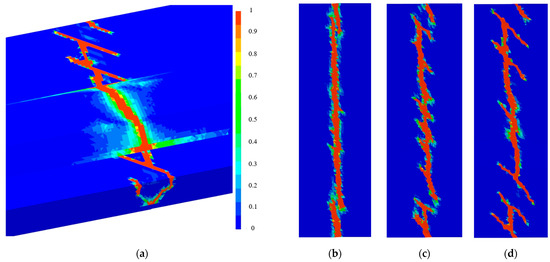
Figure 23.
Model profile. (a) The vertical profile of the model; (b) the horizontal profile at a distance of 1 m from the bedrock; (c) the horizontal profile at a distance of 2.5 m from the bedrock; (d) the horizontal profile at a distance of 4 m from the bedrock.
5.3. The Deformation of Subgrade Top Surface
Figure 24 shows the deformation curve perpendicular to the subgrade strike of the centerline of the subgrade’s top surface under the conditions of α = 22.5°, 45°, 67.5°, 90°, 112.5°, and 157.5° at the same time. It can be seen that the shape of the deformation curve was consistent with the model test. Under the same fault displacement, when the angle between the subgrade and the fault strike became larger, the uneven subgrade deformation perpendicular to the subgrade strike caused by the fault dislocation gradually decreased and then increased. The impact of line regularity also became worse. The sustainability of the subgrade was damaged due to an uneven deformation.
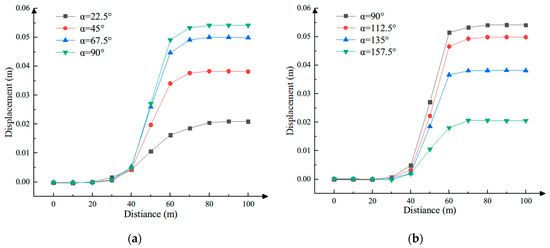
Figure 24.
The deformation curve perpendicular to the subgrade strike of the centerline of the subgrade top surface. (a) α = 22.5°, 45°, 67.5°, and 90°; (b) α = 90°, 112.5°, 135°, and 157.5°.
6. Discussion
6.1. The Deformation Mechanism
In existing research, scholars often use displacement sensors such as wire displacement meters and laser displacement meters to measure the displacement of the subgrade. The cracks on the subgrade surface are also analyzed by the naked eye and rulers. These experimental methods can only monitor the displacement at one or a few points and cannot accurately analyze the displacement and crack development on the subgrade and foundation surface during different stages of fault dislocation. This paper employs the PIV monitoring method, commonly used in physical model tests of fault dislocation in sandboxes, to achieve a refined analysis of the subgrade and the foundation deformation under different amounts of fault dislocation.
While common discrete element numerical simulation methods can accurately depict the impact of fault dislocation on subgrades, they have a slow computation speed and are generally used to study small–sized two–dimensional models. Therefore, they cannot conduct multi–condition three–dimensional numerical simulations efficiently. Additionally, previous finite element analyses have not detailed the development patterns of the subgrade and the foundation cracks under strike–slip fault dislocation through equivalent plastic strain analysis. Hence, this study utilizes the GDEM numerical simulation software, independently developed by the Institute of Mechanics, Chinese Academy of Sciences. By monitoring the change in the combined damage factor, the subgrade and its lower foundation fracture induced by a fault dislocation are analyzed. Compared to same–sized discrete element simulation models, this method shortens the computation time.
In summary, by improving model testing and numerical simulation methods, this paper reveals the development patterns of S–shaped displacement, tension–shear cracks, and compressive crushed zones in railway subgrades under strike–slip fault dislocation. The impact of different angles between the fault strike and the subgrade strike on subgrade deformation is also analyzed. The deformation mechanism of the railway subgrade under strike–slip fault dislocation is revealed more comprehensively.
6.2. Limitations of This Study
There is no perfect theory of subgrade deformation under fault dislocation. In geological engineering, a theoretical formula for the deformation of crustal plates due to strike–slip fault dislocations has been established (Equation (4)). It comes from the screw dislocation theory of crystal materials [9].
where b is the relative displacement between the fault fixed plate and the dislocation plate; x is the horizontal distance perpendicular to the fault strike; d is the locking depth of the fault; and v is the displacement of the crustal surface along the fault strike.
This formula can be used to quantitatively characterize the S–shaped deformation of the crustal surface. The shape is similar to the deformation of the top surface of the subgrade under a strike–slip fault dislocation. This formula can be improved to analyze the deformation of subgrade top surfaces. The model test and numerical simulation results mentioned can provide support for the establishment of the theory.
7. Conclusions
- (1)
- When the fault dislocation was slight, the deformation of the subgrade surface was diffuse, with the subgrade showing an S–shaped dislocation along the fault strike. Simultaneously, the soil on the surface of the subgrade and the foundation was thrust to both sides of the fault. This phenomenon adversely affects the sustainability of the subgrade. During a severe fault dislocation, numerous en echelon tension–shear cracks appeared on the surface of the subgrade and foundation, and compression crush zones emerged on the surface of the subgrade slope. Taking the intersection of the centerline of the subgrade top surface and the fault strike as the center, the tension–shear cracks and compression crush zones were roughly distributed in a centrosymmetric manner. Due to the presence of tension–shear cracks and the thrusting effect, the density of the subgrade significantly decreased, leading to cavities and subsidence on the subgrade’s surface.
- (2)
- When the angle between the fault strike and the subgrade strike increased from 22.5° to 157.5°, the range of uneven deformation of the subgrade induced by the fault dislocation decreased and then increased. When the angle was 90°, the range of uneven deformation was the smallest. To minimize the impact of the fault dislocation on the smoothness of railway lines, it is recommended that the angle between the fault strike and the subgrade strike should be 90° or close to 90°.
- (3)
- When the angle between the fault strike and the subgrade strike increased from 22.5° to 157.5°, the angle between the main tension–shear crack on the top surface of the subgrade and the fault strike showed a trend of increasing and then decreasing. The maximum angle was 17.5° when the angle between the fault strike and the subgrade strike was 112.5°. The minimum angle was 6.5° when the angle between the fault strike and the subgrade strike was 22.5°. This conclusion can provide a reference for accurately determining the direction of the main tension–shear crack on the top surface of the subgrade.
- (4)
- When the angle between the fault strike and the subgrade strike increased from 22.5° to 157.5°, the compressive stress along the subgrade strike decreased, while the tensile stress along the subgrade strike gradually increased. Tensile stress was the main cause of tension–shear cracks on the subgrade surface, while compressive stress was the main cause of the compression crush zone on the subgrade slope.
- (5)
- The tension–shear cracks formed in the subgrade and foundation were spiraled. With an increase in the depth of the subgrade and foundation, the angle between the cracks and the fault strike gradually decreased, converging on the strike–slip fault.
Author Contributions
Conceptualization, J.L., Y.Y. and J.Y.; methodology, J.L.; software, J.L.; validation, J.L., Y.Y., D.C., H.Y. and J.Y.; formal analysis, J.L.; investigation, J.L.; resources, J.L.; data curation, J.L.; writing—original draft preparation, J.L.; writing—review and editing, J.L.; visualization, J.L.; supervision, Y.Y., D.C., H.Y. and J.Y.; project administration, H.Y. and J.Y.; funding acquisition, Y.Y. All authors have read and agreed to the published version of the manuscript.
Funding
This research was supported by the Fund of China Academy of Railway Sciences Group Co., Ltd. (No. 2021YJ314).
Data Availability Statement
Data is contained within the article.
Conflicts of Interest
Authors Jingwei Liang, Yangsheng Ye, Degou Cai, Hongye Yan and Junkai Yao were employed by the company Railway Engineering Research Institute, China Academy of Railway Sciences Corporation Limited, Beijing, China. The remaining authors declare that the research was conducted in the absence of any commercial or financial relationships that could be construed as a potential conflict of interest.
References
- Mao, J.; Jiang, D.W.; Yang, Q.H.; Zhang, Y.G. Discussion on typical disaster reduction route selection of Yunnan–Guangxi railway. High Speed Railw. Technol. 2018, S2, 62–67. [Google Scholar]
- Zhang, X.B.; Yu, H.; Yu, X.; Guo, C.B.; Wu, R.A.; Wang, Y.; Zhong, N. Preliminary study on the Late Quaternary activity of important active fault zones along the Yunnan–Tibet railway. Prog. Earthq. Sci. 2024, 54, 94–109. [Google Scholar]
- Zhao, L.N. Route selection and engineering measures for high speed railway crossing active fault zone. China Railw. 2023, 7, 7–13. [Google Scholar]
- Liu, Y.; Ren, Y.F.; Wang, D.R.; Wen, R.; Huang, Y.; Wang, H. Research on co–seismic displacement of ground surface at Liuhuanggou bridge of Lanzhou–Xinjiang high–speed railway caused by the 2022 Menyuan earthquake in Qinghai province. China Railw. Sci. 2022, 43, 42–50. [Google Scholar]
- Zhang, Y.F.; Yuan, K.; Zhou, W.J.; Fan, J.W. Study on structural deformation characteristics and surface crack distribution of girder tunnel across Lenglongling fault caused by Menyuan earthquake. Chin. J. Rock Mech. Eng. 2023, 42, 1055–1069. [Google Scholar]
- Wang, J.J. Coseismic, Postseismic and Interseismic Stress Triggerings. Ph.D. Thesis, Wuhan University, Wuhan, China, 2010. [Google Scholar]
- Riedel, W. Zur mechanik geologischer brucherscheinungen. Geol. Und Paleontol. B 1929, 8, 345–368. [Google Scholar]
- Naylor, M.A.; Mandl, G.; Supesteijn, C.H.K. Fault geometries in basement–induced wrench faulting under different initial stress states. J. Struct. Geol. 1986, 8, 737–752. [Google Scholar] [CrossRef]
- Savage, J.C.; Burford, R.O. Geodetic determination of relative plate motion in central California. J. Geophys. Res. 1973, 78, 832–845. [Google Scholar] [CrossRef]
- Cai, Q.P.; Wu, H.W.; Hu, P.; Chen, X.X.; Li, S.C. Centrifuge experimental study of dynamic responses of clay stratum overlying a strike–slip fault. Rock Soil Mech. 2018, 39, 2424–2432. [Google Scholar]
- Hardy, S.; Finch, E. Discrete element modelling of the influence of cover strength on basement–involved fault–propagation folding. Tectonophysics 2006, 415, 225–238. [Google Scholar] [CrossRef]
- Zhang, J.J.; Si, C.L.; Zhao, Y.J.; Liu, H.; Hou, J.Q. Reinforcement measures and deformation failure modes of subgrade on embedded reverse fault. Rock Soil Mech. 2013, 34, 2460–2467. [Google Scholar]
- Ai, S.J. Study on the Influence of Dip–Slip Faulting on Subgrade Stability and Engineering Failure Resistance Technology. Master’s Thesis, Lanzhou Jiaotong University, Lanzhou, China, 2021. [Google Scholar]
- Ji, Y. Strike–Slip Fault Zone Activities’ Influence to the Stability of Roadbed and Research on Engineering Anti Breaking Technology. Master’s Thesis, Lanzhou Jiaotong University, Lanzhou, China, 2021. [Google Scholar]
- Ma, S.J. Study on Tunnel Disaster Response Mechanism and Disaster Range Prediction under Active Fault Dislocation. Master’s Thesis, Southwest Jiaotong University, Chengdu, China, 2022. [Google Scholar]
- Li, L. Study on the Influence Mechanism of Active Fault Zone on Metro Viaduct. Master’s Thesis, Chang’an University, Xi’an, China, 2022. [Google Scholar]
- Li, H. Numerical Simulation of Coseismic Surface Deformation and Stick–Slip Dislocation Process of Strike–Slip Fault. Ph.D. Thesis, Institute of Geology, China Earthquake Administration, Beijing, China, 2018. [Google Scholar]
- TB 10001–2016; Code for Design on Subgrade of Railway. China Railway Publishing House Co., Ltd.: Beijing, China, 2017.
- Li, Y.H.; Zhu, H.H.; Katsutoshi, U.; Akitoshi, M. Deformation field measurement for granular soil model using image analysis. Chin. J. Geotech. Eng. 2004, 26, 36–41. [Google Scholar]
- Zhang, G.; Mu, T.P.; Zhang, J.M. Displacement measurement using image analysis in centrifuge modeling of slopes. Chin. J. Geotech. Eng. 2007, 29, 94–97. [Google Scholar]
- Thielicke, W.; Sonntag, R. Particle Image Velocimetry for MATLAB: Accuracy and enhanced algorithms in PIVlab. J. Open Res. Softw. 2021, 9, 12. [Google Scholar] [CrossRef]
- Feng, J. Physical Analog Modeling of Main Controlling Factors of Strike–Slip Fault Formation and Evolution and Its Application. Ph.D. Thesis, Northeast Petroleum University, Daqing, China, 2022. [Google Scholar]
Disclaimer/Publisher’s Note: The statements, opinions and data contained in all publications are solely those of the individual author(s) and contributor(s) and not of MDPI and/or the editor(s). MDPI and/or the editor(s) disclaim responsibility for any injury to people or property resulting from any ideas, methods, instructions or products referred to in the content. |
© 2024 by the authors. Licensee MDPI, Basel, Switzerland. This article is an open access article distributed under the terms and conditions of the Creative Commons Attribution (CC BY) license (https://creativecommons.org/licenses/by/4.0/).